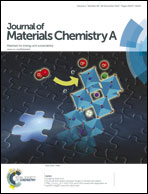Improving the thermoelectric performance of TiNiSn half-Heusler via incorporating submicron lamellae eutectic phase of Ti70.5Fe29.5: a new strategy for enhancing the power factor and reducing the thermal conductivity
Abstract
The concept of a composite derived by incorporating a second minor phase in bulk thermoelectric materials has established itself as an effective paradigm for optimizing high thermoelectric performance. In this work, the incorporation of submicron lamellae eutectic phases into cheap, abundant and non-toxic TiNiSn half-Heusler is extended for the first time to optimize its thermoelectric performance. Half-Heusler (HH) TiNiSn/eutectic Ti70.5Fe29.5 composites were fabricated by employing the arc-melting route, followed by the spark plasma sintering (SPS) technique. Incorporating the metallic submicron lamellae eutectic phase of Ti70.5Fe29.5 into the HH TiNiSn matrix results in a substantial increase in the power factor (∼57% higher than TiNiSn HH) and simultaneous reduction (∼25% lower than TiNiSn HH) in the thermal conductivity, leading to an enhanced thermoelectric figure-of-merit (ZT) of 0.41 at 773 K for the half-Heusler (HH) TiNiSn/eutectic Ti70.5Fe29.5 composite with a mass ratio a 33 : 1, which is 105% higher than its counterpart TiNiSn HH. This enhancement in power factor is primarily due to an increase in electrical conductivity, resulting from the inclusion of the metallic Ti70.5Fe29.5 eutectic phase, while the reduction in thermal conductivity can be ascribed to the enhanced phonon scattering by numerous lamellae interfaces of β-Ti and TiFe of the eutectic phase and also their interfaces with the HH phase. The effective value of the thermal conductivity of HH TiNiSn/eutectic Ti70.5Fe29.5 composites, calculated by the effective medium theory in the light of Maxwell–Eucken approximations, matches well with the experimental value of thermal conductivity.


 Please wait while we load your content...
Please wait while we load your content...